
PREV ARTICLE
NEXT ARTICLE
FULL ISSUE
PREV FULL ISSUE
GRASPABLE TESTIMONIES: GNADENPFENNIGEI learned a new numismatic word this week: gnadenpfennige. Here's an
excerpt from a September 25, 2014 CoinsWeekly article on the topic. -Editor
On 16 October, 2014, Gorny & Mosch will auction off the collection of Werner Jaggi (1927-2002) in Munich with auction sale #226. Over the course of several decades, the distinguished expert on religious art mainly of the Alpine region assembled the largest collection of numismatic testimonies on religious beliefs and customs the market has ever seen. After the natural sciences have explained the world to us, we have lost the understanding of the unconditional belief that is expressed in these objects. Hence, only few people can still appreciate what a gnadenpfennig or an amulet may have meant to its wearer back then. Way into the 19th century, all people – craftsmen, peasants and noblemen alike – had felt victim to an unpredictable fate. Life could have been cut short at every second. A thunderstorm destroyed the crop and caused famines. A plague cost the life of the entire family. Help could only be expected from divine entities, security could only be achieved in the Netherworld. The human being was both powerless and defenseless. Naturally, the distressed one looked for a way to do something in this state of emergency. He went on a pilgrimage or pledged a holy trip, a financial donation, in order to have his share in the blessing – and this, by the way, is something not only the Catholics did. When we today are faced with ‘pilgrimage’ as a term, then the important medieval pilgrimage destinations spring to mind: Jerusalem, Santiago, and Rome. Central to the people in Baroque times, though, were local pilgrimage destinations that were systematically enlarged by the leading figures of the Counter Reformation. Instead of a huge, one of a kind experience, which only a small elite circle amongst the believers could afford, a comprehensive infrastructure was created thanks to which it became possible for the ordinary believer, too, to enjoy a little religious timeout, at some instances a couple of times per year. Another kind of source for this chapter of our cultural history are pendants, amulets, crosses and so on, as they are available for sale as memento and talisman in front of the pilgrimage church in many countries. These ‘gnadenpfennige’ were produced in large quantities. They were often consecrated explicitly in the context of the service and hence ‘activated’, as it were. Most of them feature the cult image of the pilgrimage. Thanks to their accurate depictions they can be taken as magnificent testimonies to local history. Their illustrations provide insight into particular religious notions, myths and legends and thus into a past which is seldom referred to in the non-churchly historical narrative. The sub-form of the religious medal became wearable thanks to a loop or a punched hole. And these items definitely were being worn, sometimes around the neck, but much more often being sewed onto the hat or the clothes. They simultaneously served as visible proof of the piety of its wearer to the public eye and the believer’s self-assurance of the divine powers. The Werner Jaggi Collection comprises mainly European gnadenpfennige from four centuries. They were consecrated to a very special saint or refer to a certain pilgrimage. In addition, they mirror how animated both piety and veneration of saints were in the Catholic territories in the post-Reformation era which provided the people with support and guidance in their life before the Enlightenment ushered in the modern era. Here are some images from the article. Be sure to read the complete version
online. It has a link to the Gorny & Mosch site. -Editor
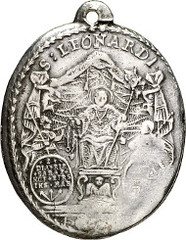 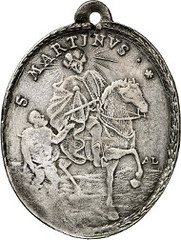
St. Leonard of Noblat. Silver pendant 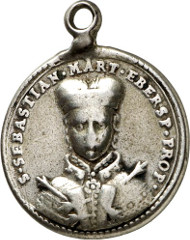
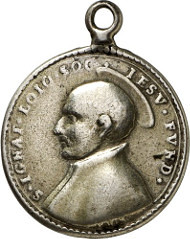
Ebersberg, Cloister Church of St. Sebastian. Cast silver pendant 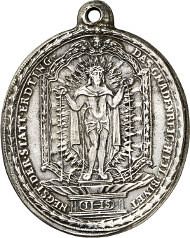

Erding. Pilgrimage Church Holy Blood. Silver pendant To read the complete article, see:
Wayne Homren, Editor The Numismatic Bibliomania Society is a non-profit organization promoting numismatic literature. See our web site at coinbooks.org. To submit items for publication in The E-Sylum, write to the Editor at this address: whomren@gmail.com To subscribe go to: https://my.binhost.com/lists/listinfo/esylum All Rights Reserved. NBS Home Page Contact the NBS webmaster 
|